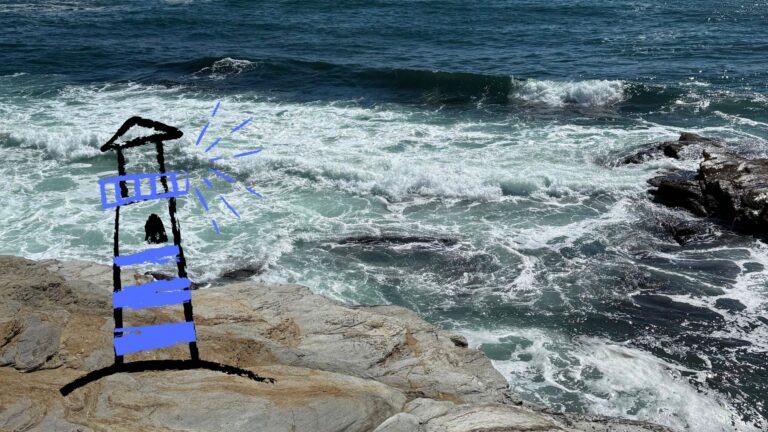
When the Quiet Cracks Spread: How Leaders Can Reconnect and Get Creative – Fast
I can still picture it—walking through my northwest Chicago neighborhood with friends,


I’ll admit it—I am a wimp when it comes to cold water. I’m the person who tiptoes into the ocean, gasping at every icy wave and muttering under my breath about how freezing it feels. Meanwhile, my husband barrels straight in like it’s nothing.
“Come on, Katie, just take the plunge and get it over with!” he’ll shout, splashing water in my direction while I linger, half-committed, ankle-deep.
It’s the last step—the full submersion—that I dread most. Everyone insists, “It feels better once you’re in.” Maybe so, but somehow I’m always still shivering.
So I hover. Not fully on the shore, but not fully swimming either. Safe in the shallows, but never experiencing the rush of diving deep.
Our thinking works the same way. Sometimes we stay on the surface—memorizing, repeating, reacting—never venturing beyond the obvious. Surface thinking is easy, quick, and safe. But just like floating on top of the water, it doesn’t take us anywhere.
When we dip below the surface, we enter the realm of shallow thinking. It’s a step closer to depth, but still limited. Shallow thinking focuses on recall and recognition, connecting facts without truly stretching them. It answers “when” and “where,” but rarely dares to ask “why” or “what if.” It feels comfortable, but it keeps us circling in the status quo, surviving instead of transforming.
So let’s get thinking and begin wading into the shallow.
On a family vacation years ago, we took the grandkids to the beach. Before we even left the condo, I had my checklist ready: sun umbrella, sunscreen, towels, snacks, sand toys, extra clothes, and of course, the camera. By the time we hauled everything across the hot sand and claimed our spot, I felt like I’d already accomplished something big.
And from the outside, it looked like we had the perfect beach day lined up. The checklist was complete. The kids were laughing, splashing at the edge of the surf, and declaring that they had “gone swimming.” But here’s the truth: they were only knee-deep. They weren’t feeling the tug of the current, the sting of saltwater in their eyes, or the rush of diving under a wave. They thought they had experienced the ocean—but really, they’d only skimmed the surface.
That’s what shallow thinking feels like. It doesn’t feel wrong. In school, students ace the quiz because they memorized the facts. At work, teams check off their tasks, and the meeting ends on schedule. On paper, it looks like progress. Everyone pats themselves on the back, the way I did with my perfectly packed beach bag.
But “good enough” thinking keeps us stuck. Research shows that surface-level learning is tied to short-term recall but quickly fades without deeper processing. It creates the illusion of mastery. This type of thinking may appear confident, but it lacks competence. In organizations, it shows up as recycling last year’s strategies simply because “that’s how we’ve always done it.” It looks efficient in the moment, but it quietly drains creativity and resilience.
John Dewey once argued that we don’t actually learn from experience alone—we learn from reflecting on experience. Shallow thinking skips that step. It lets us move on quickly, but it robs us of the growth that comes from wrestling with ideas and asking better questions.
I get it – staying in the shallows might feel comfortable, but remember, it comes at a cost. When organizations stick to surface-level patterns, recycling last year’s plan or relying solely on “what worked before,” they miss the opportunity to innovate. It’s like unpacking the picnic, arranging the towels, and never leaving the sand. You’ve gone through the motions, but you’ve missed the point.
Research makes the same case. McKinsey (2023) found that companies with strong resilience practices, such as encouraging learning, reflection, and adaptive thinking, generated approximately 10% higher returns during downturns compared to their less resilient peers. In other words, when the waves got rough, the shallow thinkers sank while the deeper thinkers swam.
And it’s not just organizations. For individuals, shallow thinking often breeds stagnation. Deloitte’s Global Human Capital Trends report (2023) highlights that the future of work depends on activating human capabilities like curiosity, creativity, and critical thinking. Without those, we fall into what I call the checklist version of life: busy but not bold, active but not adaptive.
Shallow thinking is like building a house on sand. It might stand for a little while, but the first strong tide reveals its weakness, washing it away and leaving behind nothing but fragments of what once was.
The good news? Moving from shallow to deep doesn’t require diving headfirst into the icy unknown. You don’t have to be like my husband—charging full speed into the waves and shouting back for everyone else to hurry up. For the rest of us (the slow waders), it starts with something much simpler—and far less intimidating: asking, “What else?”
It may seem insignificant, but this tiny question holds great power. Research on metacognition—the awareness of our own thinking—shows that reflective questioning strengthens problem-solving, deepens learning, and helps ideas stick (Flavell, 1979; Tanner, 2012). In other words, when we pause to ask “what else,” we interrupt autopilot and give curiosity and creativity a chance to surface.
Every “what else” is like wading just a little deeper into the ocean. First your ankles, then your knees, then suddenly the sand drops away. The water lifts you, and you’re not just standing still anymore—you’re swimming. You may not cannonball in like my husband, but step by step, question by question, you still find yourself in the deep—the place where discovery really happens.
Whether you’re like my husband—charging full speed into the waves—or more like me, inching in one gasp at a time, the goal is the same: to go deeper.
Surface and shallow thinking might feel safe, but they’ll never give us the whole experience. It’s only when we risk the plunge—or take those steady steps—that we move beyond survival into discovery, resilience, and transformation.
So the next time you’re tempted to stay knee-deep, pause and ask, “What else?” Whether you dive or wade, what matters most is that you don’t stay on the surface. The deeper waters are where real growth—and real change—begin.
The surface will keep you comfortable, but only the deep will change you.
If shallow thinking keeps us safe, what happens when we’re finally brave enough to push past the discomfort? In the next blog, we’ll delve into the power of Productive Struggle, exploring why actual growth often lies within frustration, and how learning to tackle challenging tasks builds stronger, bolder thinkers.
Deloitte Insights. (2023). 2023 Global Human Capital Trends: New Fundamentals for a Boundaryless World. https://www.deloitte.com/us/en/insights/topics/talent/human-capital-trends.html
Share Post:

I can still picture it—walking through my northwest Chicago neighborhood with friends,

A lighthouse doesn’t shine just for decoration; it exists because lives depend

A Beacon on the Shore We’re drowning in information and starving for